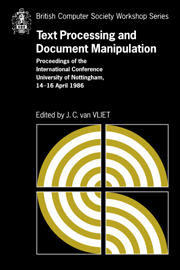 Text Processing and Document Manipulation
Text Processing and Document Manipulation Book contents
- Frontmatter
- Contents
- Preface
- The Design of Lucida®: an Integrated Family of Types for Electronic Literacy
- Tabular Typography
- A Simple Mechanism for Authorship of Dynamic Documents
- VORTEXT: VictORias TEXT reading and authoring system
- An Approach to the Design of a Page Description Language
- Intelligent Matching and Retrieval for Electronic Document Manipulation
- A Disciplined Text Environment
- Semantic Guided Editing: A Case Study On Genetic Manipulations
- Trends and Standards in Document Representation
- Textmaster – document filing and retrieval using ODA
- Combining Interactive Document Editing with Batch Document Formatting
- Formatting Structure Documents: Batch versus Interactive?
- Advanced Catalogue Production at Unipart
- Legibility of Digital Type-fonts and Comprehension in Reading
- An Overview of the W Document Preparation System
- Grif: An Interactive System for Structured Document Manipulation
- Procedural Page Description Languages
- A Strategy for Compressed Storage and Retrieval of Documents
- CONCEPT BROWSER: a System for Interactive Creation of Dynamic Documentation
- An Integrated, but not Exact-Representation, Editor/Formatter
- An Annotated Bibliography on Document Processing
- Systems used
Semantic Guided Editing: A Case Study On Genetic Manipulations
Published online by Cambridge University Press: 05 May 2010
- Frontmatter
- Contents
- Preface
- The Design of Lucida®: an Integrated Family of Types for Electronic Literacy
- Tabular Typography
- A Simple Mechanism for Authorship of Dynamic Documents
- VORTEXT: VictORias TEXT reading and authoring system
- An Approach to the Design of a Page Description Language
- Intelligent Matching and Retrieval for Electronic Document Manipulation
- A Disciplined Text Environment
- Semantic Guided Editing: A Case Study On Genetic Manipulations
- Trends and Standards in Document Representation
- Textmaster – document filing and retrieval using ODA
- Combining Interactive Document Editing with Batch Document Formatting
- Formatting Structure Documents: Batch versus Interactive?
- Advanced Catalogue Production at Unipart
- Legibility of Digital Type-fonts and Comprehension in Reading
- An Overview of the W Document Preparation System
- Grif: An Interactive System for Structured Document Manipulation
- Procedural Page Description Languages
- A Strategy for Compressed Storage and Retrieval of Documents
- CONCEPT BROWSER: a System for Interactive Creation of Dynamic Documentation
- An Integrated, but not Exact-Representation, Editor/Formatter
- An Annotated Bibliography on Document Processing
- Systems used
Summary
ABSTRACT
This paper describes the BIOSTATION, a generalized document preparation system, developed to guide an interactive editing of biological sequences by taking into account their semantics. This paper also focusses on the use of a document preparation system as the mediator for a larger application.
Introduction
The BIOSTATION is a generalized document preparation system, developed for the CRBM** and in use since May 85, able to guide an interactive editing of biological sequences by taking into account their semantics. This semantic is extracted at editing time from the document itself by an integrated expert system, and is used to express the structuration. This paper also focusses on the use of a document preparation system as the mediator for a larger application.
Genetic sequences are observed in this approach as generalized documents. This choice allows to associate convenient, and so more legible, visual representations to the abstract aspects of biological sequences semantic.
At first, we explain how semantic information on the sequences is obtained and used to guide editing. The biostation architecture is presented in a second section.
Problem position
The genetic information which allows organic cells to synthesize proteins is kept in genes. These genes are linear strings built with four types of molecules (Adenin, Thymin, Guanin, Cytosin) called nucleotids. The non biologist readers can refer to [Hélène 84]. The studied length of such strings can be up to 30000 atoms.
A gene can be analysed by the biologists to explicit its formula as a word on (A, T, G, C), and operations can be done on the gene (in vitro or in vivo) to modify it by insertions or deletions of some parts, at precise positions.
- Type
- Chapter
- Information
- Text Processing and Document ManipulationProceedings of the International Conference, University of Nottingham, 14-16 April 1986, pp. 90 - 106Publisher: Cambridge University PressPrint publication year: 1986
- 1
- Cited by


